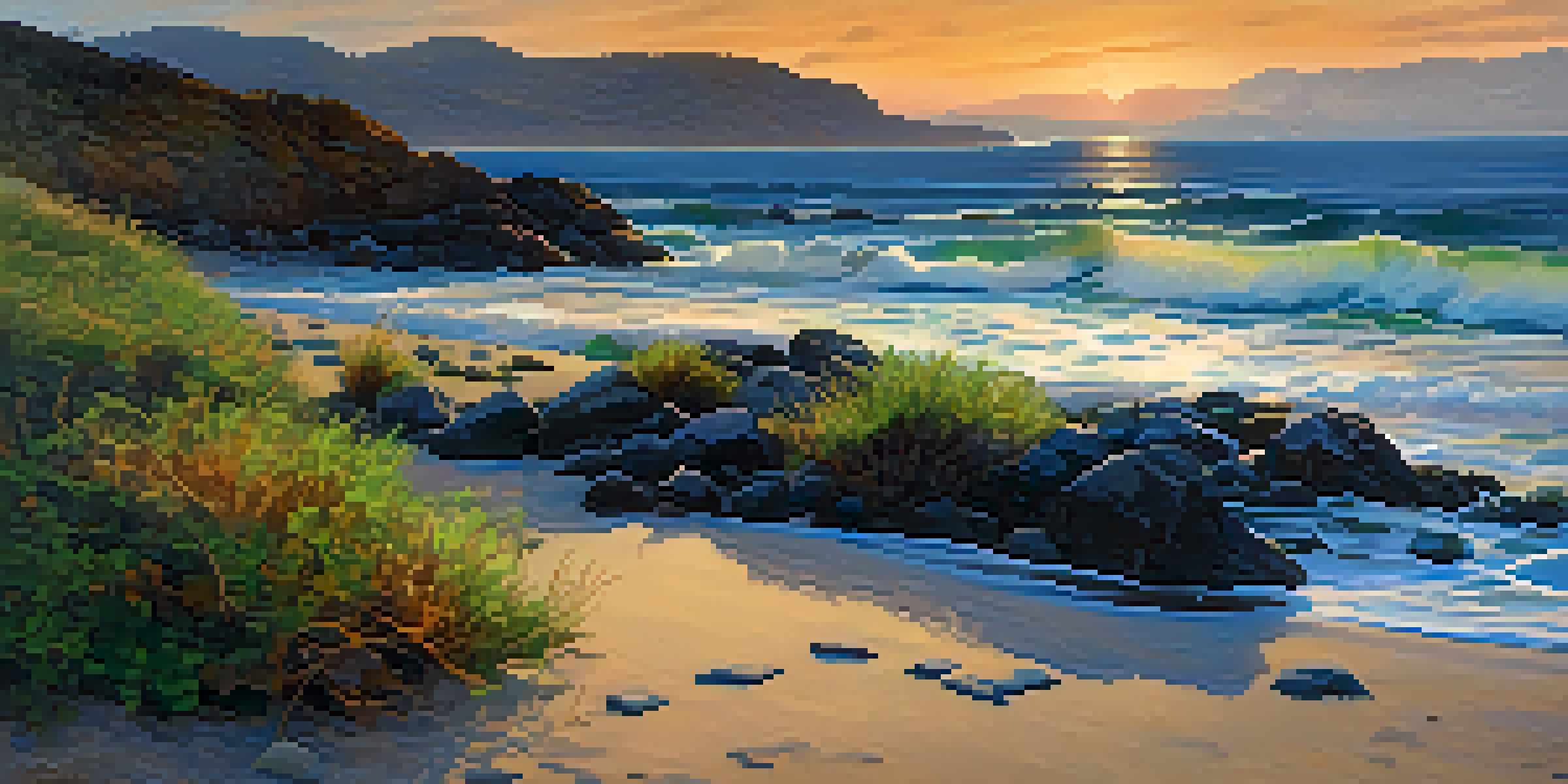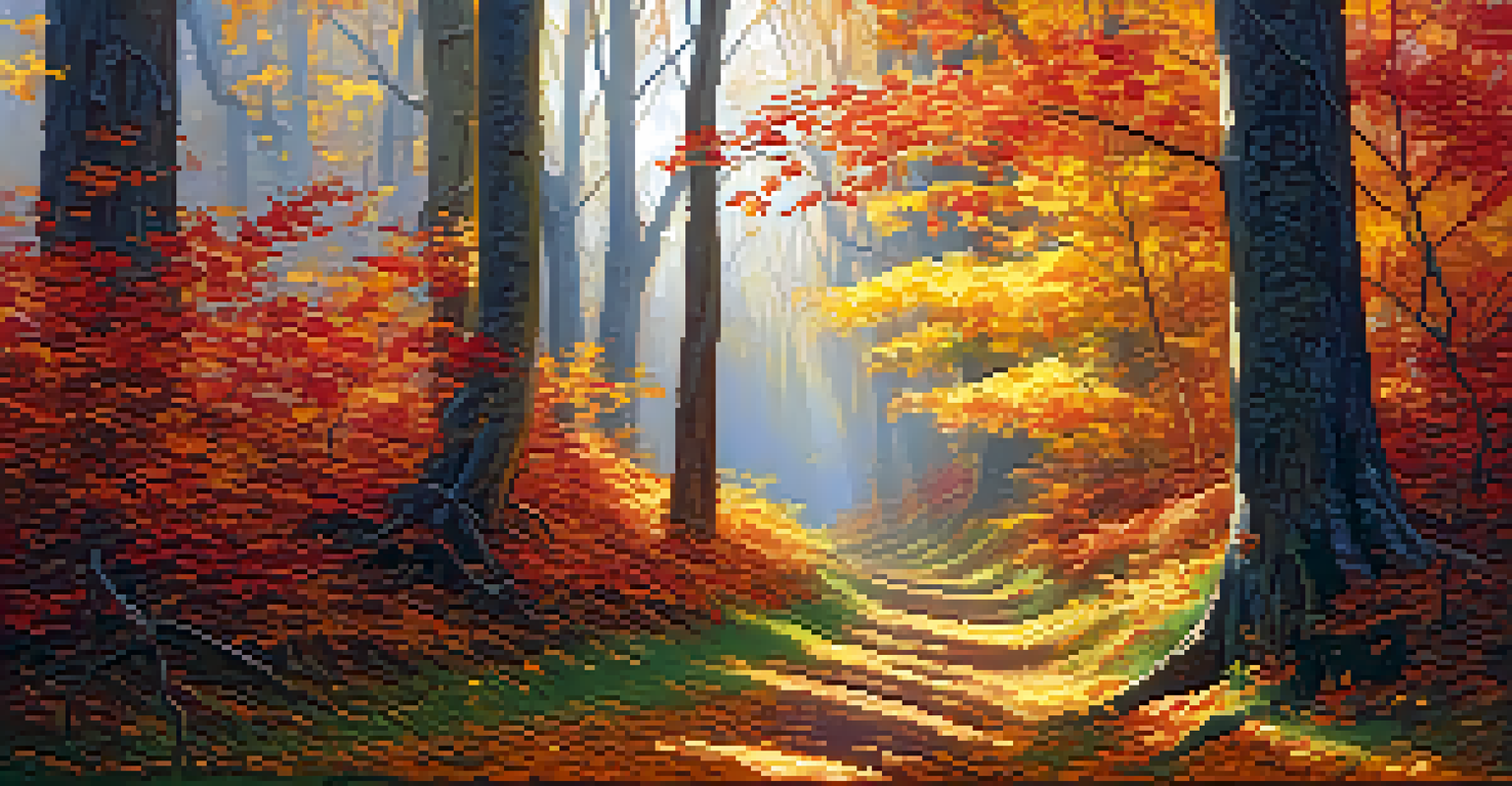Nature's Palette: Color Usage in Environmental Art

The Role of Color in Environmental Art
Color is a fundamental element in environmental art, shaping our perception and emotional response to nature. Artists use color to evoke feelings, whether it's the calming blues of a serene lake or the vibrant greens of lush forests. This intentional use of color helps viewers connect with the artwork and, by extension, the environment it represents.
Color is the keyboard, the eyes are the harmonies, the soul is the piano with many strings.
Different colors carry distinct meanings and associations. For example, warm colors like red and orange can convey energy and excitement, while cool colors like blue and green often evoke tranquility and peace. Understanding these associations enables artists to communicate their messages more effectively through their work.
Moreover, the colors found in nature change with the seasons, influencing artists' choices and techniques. As leaves turn from green to orange and gold in autumn, artists are inspired to capture these transformations, reminding us of the beauty and impermanence of the natural world.
Nature as the Ultimate Color Palette
Nature itself offers an endless array of colors that artists draw upon for inspiration. From the vibrant hues of wildflowers to the soft pastels of a sunset, the natural world showcases a stunning spectrum that can be both awe-inspiring and humbling. Artists often find themselves captivated by these colors, incorporating them into their works to reflect the beauty around them.

For instance, an artist might use the deep blues and greens of a coastal scene to evoke the feeling of serenity and solitude one might experience by the ocean. This not only highlights the colors of nature but also invites viewers to share in that experience, creating a deeper emotional connection with the artwork.
Color Evokes Emotional Responses
Artists use color intentionally to connect viewers emotionally with nature, using hues to convey feelings like tranquility or excitement.
Additionally, many artists strive to recreate the colors they see in nature using sustainable materials and techniques, further emphasizing the importance of environmental consciousness. This practice not only celebrates nature’s beauty but also encourages a deeper appreciation for preserving it.
Symbolism of Colors in Environmental Art
Colors often carry significant symbolic meanings, which artists can tap into to enhance their messages. For example, the color green is frequently associated with growth, renewal, and the environment itself, making it a popular choice in environmental art. By choosing specific colors, artists can communicate complex ideas about nature and our relationship with it.
The earth without art is just 'eh'.
Similarly, colors like brown and earth tones are often used to represent stability and connection to the earth. When artists incorporate these colors, they remind viewers of the fundamental ties we have to our planet and the importance of nurturing it. This symbolism can provoke thought and inspire action regarding environmental issues.
Moreover, the use of contrasting colors can highlight the tension between nature and human activity. Bright, unnatural colors might symbolize pollution or urbanization, drawing attention to the impact we have on our surroundings. This juxtaposition can be a powerful way to encourage viewers to reflect on their own habits and their consequences.
Techniques for Color Application in Environmental Art
Artists employ a variety of techniques to apply color in their environmental art, each contributing to the overall effect and message of the piece. For example, watercolor techniques can create soft, flowing color transitions that mimic the gentle beauty of nature, while bold acrylic paints can capture the vibrancy and energy of a landscape. These choices help convey the artist's vision and connection to the environment.
Layering colors is another technique that artists use to achieve depth and texture in their work. By building up layers of different colors, artists can create a sense of movement and life within their pieces. This approach mirrors the complexity of nature, where many colors coexist and interact in intricate ways.
Nature Inspires Color Choices
The natural world serves as an endless palette for artists, encouraging them to reflect its beauty through vibrant and diverse colors.
Additionally, some artists experiment with unconventional methods, such as using natural pigments or even incorporating organic materials into their artwork. This not only enhances the authenticity of the colors used but also strengthens the connection between the art and the natural world, inviting viewers to consider the source of the colors they see.
The Impact of Light on Color Perception
Light plays a crucial role in how we perceive color, and artists often consider this when creating environmental art. The time of day, weather conditions, and even the seasons can dramatically alter the colors we see in nature. For instance, the warm golden light of a sunset can transform a landscape, making it appear more vibrant and emotionally charged.
Understanding the relationship between light and color allows artists to experiment with different effects in their work. Some may choose to depict the same scene under varying light conditions to explore how it changes our perception and emotional response. This exploration can lead to a deeper appreciation of the nuances in our environment.
Moreover, artists can use light to highlight specific colors or elements within their work, drawing viewers' attention to particular aspects of the scene. This technique not only enhances the visual impact but also encourages contemplation about the role of light and color in our connection to nature.
Environmental Messages Conveyed Through Color
Colors in environmental art often serve as a powerful tool for conveying messages about sustainability and conservation. For example, artists may use earthy tones to symbolize the importance of preserving natural habitats, urging viewers to consider their impact on the environment. This subtle yet impactful messaging can inspire change and promote awareness about ecological issues.
Additionally, bright, unnatural colors might be used to represent pollution or environmental degradation, effectively capturing the viewer's attention. By juxtaposing these colors with more natural tones, artists can create a stark contrast that highlights the need for action and responsibility in protecting our planet.
Color Communicates Environmental Messages
Colors in environmental art convey important messages about sustainability, urging viewers to reflect on their relationship with the planet.
Through their use of color, artists can spark conversations about pressing environmental topics, encouraging viewers to reflect on their own relationship with nature. This dialogue can lead to greater awareness and a collective desire to foster a more sustainable future.
The Future of Color in Environmental Art
As environmental concerns continue to grow, the use of color in environmental art is likely to evolve. Artists are increasingly embracing sustainable practices, incorporating eco-friendly materials and methods into their work. This shift not only reflects a commitment to conservation but also invites viewers to engage with the art on a deeper level.
Moreover, advancements in technology may influence how colors are perceived and used in environmental art. Digital art, for instance, allows for experimentation with color that traditional mediums might not permit. Artists can manipulate colors in ways that challenge our understanding of nature and its representation.

Ultimately, the future of color in environmental art will likely focus on fostering a greater connection between humanity and the natural world. By continuing to explore the emotional and symbolic significance of color, artists can inspire audiences to appreciate and protect the environment more passionately.